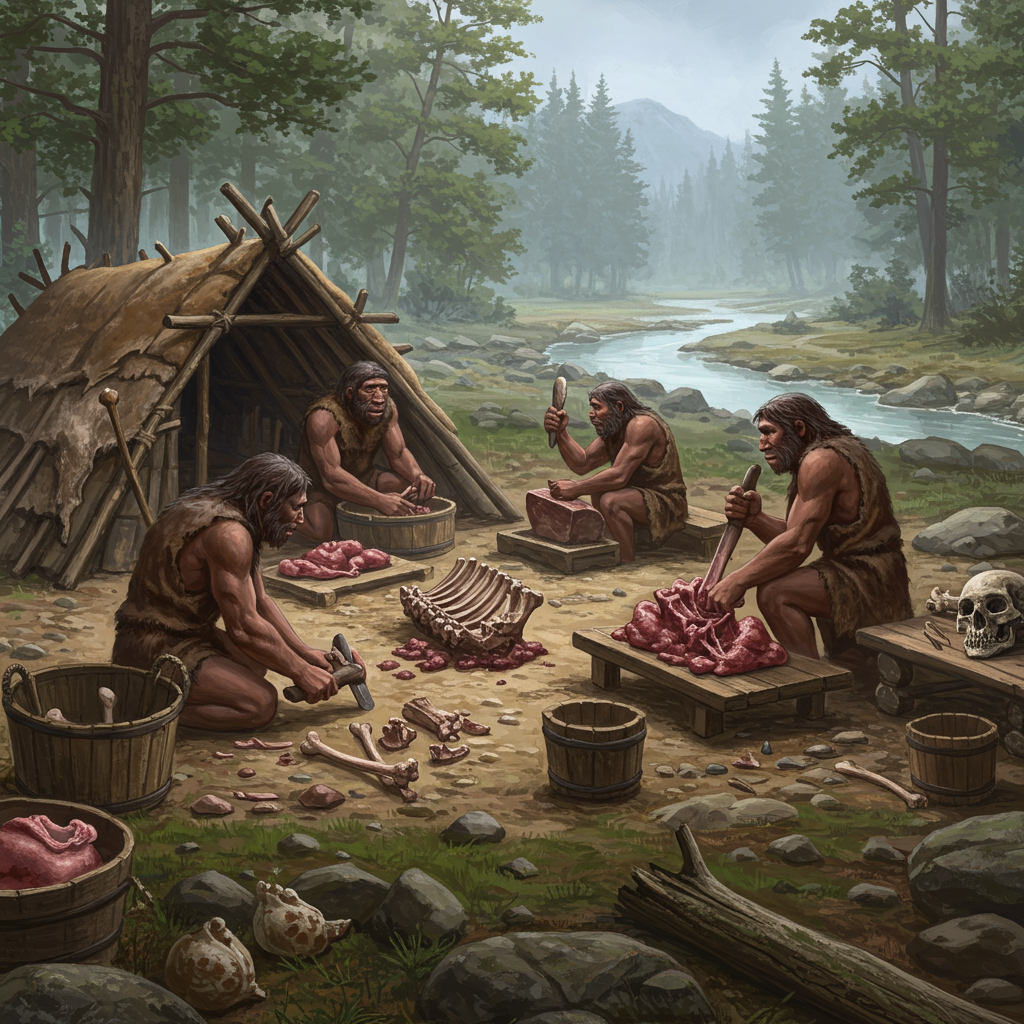Scientists have unearthed compelling evidence revealing surprising sophistication among ancient neanderthals in Germany. At a Stone Age site dating back 125,000 years, these close human relatives were not just hunting animals; they were operating what researchers are calling a “fat factory.” This organized operation involved the large-scale processing of animal bones to extract crucial fatty nutrients. The discovery challenges long-held views about Neanderthal capabilities and offers a vivid picture of their advanced survival strategies.
Unearthing an Ancient Processing Site
The remarkable findings come from the Neumark-Nord archaeological site near Halle, Germany. Excavated over several years, from 2004 to 2009, the site yielded a wealth of artifacts. Among these were approximately 120,000 bone fragments and 16,000 flint tools. Evidence of controlled fire use was also prevalent at the location. This combination of elements provided critical clues about the activities that took place there millennia ago. The systematic nature of the bone remains pointed to a deliberate process.
The Science Behind the “Fat Factory”
Researchers, publishing their work in the journal Science Advances, propose a detailed picture of the Neanderthal bone processing. They believe Neanderthals systematically selected marrow-rich bones from large animals. Using stone hammers and anvils, they would first smash these bones. This initial step likely helped access the nutritious marrow inside. However, the process didn’t stop there. Analysis showed bones were further broken into smaller pieces. This labor-intensive step suggests a secondary goal beyond simply eating marrow.
The key insight points to bone grease rendering. The fragmented bones were likely boiled for several hours. This intense boiling process would cause the fat and grease within the bone tissue to separate. As the liquid cooled, the valuable fat would float to the surface. It could then be easily skimmed off. This efficient extraction method yielded a calorie-dense resource.
A Deep Understanding of Nutrition
The existence of such a sophisticated process suggests Neanderthals understood the vital role of fat. For hunter-gatherers heavily reliant on meat, fat was essential. It provided a concentrated energy source. Importantly, it also helped them avoid a dangerous condition known as protein poisoning. This occurs when a diet is too high in lean protein but lacks sufficient fat or carbohydrates.
Historically called “rabbit starvation,” this malnutrition can be debilitating or even fatal. It overwhelms the liver’s ability to process nitrogen from protein. Neanderthals typically weighed between 110 and 175 pounds. They would have needed to limit daily protein intake to around 10 ounces (about 1,200 calories) to avoid this risk. This calorie level falls far short of typical daily energy needs for active hunter-gatherers. They required additional calories from non-protein sources like fat or carbs.
While muscle meat is lean, bones contain valuable marrow and fatty tissue. Even bones from less nourished animals retain some fat. This made bone processing a crucial survival strategy. The Neanderthals at Neumark-Nord likely utilized the site over a 300-year period. This suggests a consistent practice, indicating they fully grasped the nutritional significance of bone grease.
Evidence from the Landscape
The archaeological site wasn’t just a pile of bones; it was part of a broader landscape used by Neanderthals. The Neumark-Nord complex, first found in the 1980s, is a well-preserved interglacial ecosystem. Excavations identified different activity zones. There were areas linked to deer hunting and initial butchering. Evidence also showed processing of giant straight-tusked elephants. The “fat factory” site was a specialized area.
Analysis confirmed the bones primarily came from 172 individual large animals. These included species like horses, deer, and extinct aurochs. Crucially, the Neanderthals seemed to favor the longest bones. These bones contained the most marrow and fatty tissue. This selection underscores their targeted approach to resource extraction. Charred plant remains were also discovered. Hazelnut, acorn, and sloe plum fragments were found. These might have been added to the extracted fat, perhaps creating a “greasy broth” for flavor or extra nutrients.
Planning and Resource Management
The scale and systematic nature of the bone processing point to advanced cognitive abilities. Running a “fat factory” wasn’t a spontaneous act. It demanded planning hunts and managing carcasses. Animals had to be transported and potentially stored beyond immediate consumption. A specific area was dedicated to the complex rendering task. This suggests a level of organization previously attributed only to later modern humans.
Lead author Dr. Lutz Kindler described the activity as “intensive, organized, and strategic.” He noted this demonstrates careful resource management. The practice of extracting maximum value from carcasses through multiple steps is known as resource intensification. This discovery pushes the known timeline for such sophisticated behavior back significantly. Previous evidence for resource intensification dated to around 28,000 years ago. Neumark-Nord places it firmly at 125,000 years ago.
Challenging the “Brutish” Stereotype
This finding adds substantial weight to the growing body of evidence that refutes the traditional image of Neanderthals. Far from being unintelligent brutes, they were adaptable and innovative. Recent decades have revealed their capacity for complex behaviors. They made tools, created glue, and even produced art like engraved bones and jewelry from eagle talons.
This detailed understanding of nutrition and resource processing further highlights their intelligence. Study coauthor Geoff Smith called them “master planners.” He stated they could “look ahead, organise complex tasks, and squeeze every last calorie from their environment.” Experts not involved in the study agree on its significance. Archaeologist Ludovic Slimak sees it as “clear archaeological confirmation” of their specific strategies for processing bone lipids. Bruce Hardy views Neumark-Nord as possibly “the best example yet” of such ancient rendering.
The discovery underscores striking similarities between ancient hominins and ourselves. It shows intelligent solutions to survival challenges are a shared part of the human story. Understanding these dietary adaptations provides insight into evolutionary advantages. A high-calorie diet would have been vital for factors like energy levels, reproduction, and overall survival in challenging environments.
Frequently Asked Questions
What was the Neanderthal “fat factory” discovered in Germany?
The Neanderthal “fat factory” is an archaeological site at Neumark-Nord, Germany, dating back 125,000 years. Evidence shows Neanderthals systematically processed animal bones on a large scale. They likely smashed and boiled the bones to extract fat and grease. This site demonstrates organized efforts beyond simple butchery for immediate consumption.
Why was extracting fat so important for Neanderthals 125,000 years ago?
Extracting fat was crucial for Neanderthals as part of a balanced diet. As hunter-gatherers reliant on lean meat, they risked protein poisoning if they didn’t consume enough fat or carbohydrates. Fat provided essential calories and helped prevent this dangerous condition. Bone marrow and grease were rich sources of these necessary fats.
How does this discovery change what we thought about Neanderthal intelligence?
This finding significantly challenges the stereotype of Neanderthals as simple or unintelligent. Running a “fat factory” required planning, organization, specific skills, and a deep understanding of nutrition. It demonstrates resource intensification and strategic thinking previously thought to be unique to later modern humans. It adds to other evidence showing Neanderthals were complex, adaptable, and intelligent.




